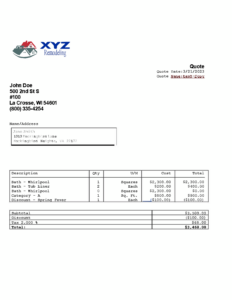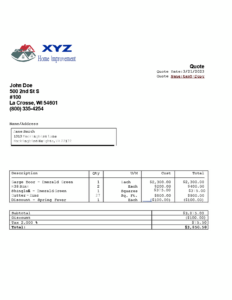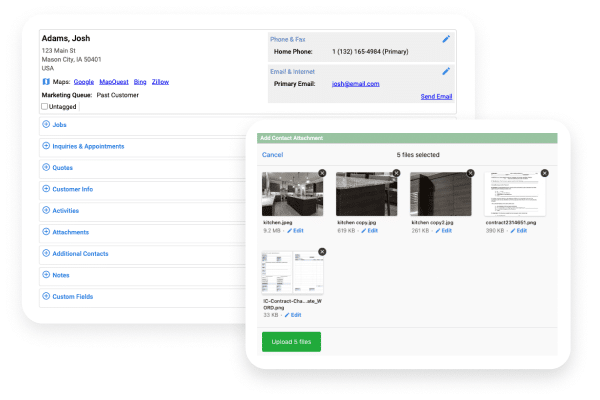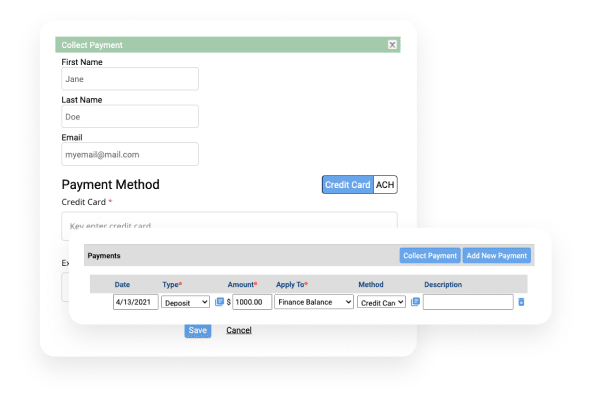Remodeling & Home Improvement Estimate Template
MarketSharp Makes the Estimate Process Easy.
Create quotes/estimate through our software with MarketSharp’s Vendo and One Click Contractor integrations.

(for Bathroom, Kitchen, & General)
If you are embarking on a bathroom, kitchen, or general remodeling project, it’s vital you consider all elements of the project in order to accurately provide an estimate for costs and timing. Our customizable remodel estimate template for bathroom, kitchen, and general covers all the essentials.

Any home improvement project with a reputable contractor starts with a plan. Put all the elements of the project, including the scope of work, timeline, and cost projections into our home improvement estimate template and customize as needed.
*Depending on where your business is located, you may need to add specific legal terms, language, and/or clauses not included in this template. We recommend consulting a lawyer or legal service about what legal copy to include.
Managing Home Improvement & Remodeling Estimates Effectively
When you’re juggling lots of different remodeling or home improvement jobs, it’s easy to get overwhelmed with all you have to do. Putting a system in place to manage all your estimates will go a long way toward keeping you organized and on track, so you can focus on other parts of your business.
Here, we offer you a few ways to effectively manage your remodeling and home improvement estimates.
Using a Bid/Estimate Management System
Using a bid/estimate management system is a valuable, time-saving way to keep you organized. It will also significantly cut down on the amount of paper you have floating around and need to keep track of and file.
What’s more, a document management system can help you smooth out the remodeling/home improvement sales process from start to finish. You can create, organize, and store your estimates, contracts, service documents, job-related photos, and more in one central place.
Everything is right where you need it and easy to share with your crews and customers.


Sending Follow Ups
You created the estimate, emailed it to your prospective customer and now you’re just waiting. And waiting. Did you know that 80% of sales can require an average of five follow ups in order to finalize the deal?
Don’t leave any potential jobs or money on the table—if you don’t hear anything back about the remodeling or home improvement estimate you’ve sent, be persistent and send a follow-up email. It’s always possible the customer meant to get back to you, or maybe your follow up will help nudge them along.
Incorporate following up on estimates and bids as a best practice for handling estimates. It’s a simple yet effective way to ensure you close the sale.
Making Deposit Collection Easy
So, your customer has accepted the estimate. Now you need to make sure the job actually happens. One method for ensuring the job isn’t canceled or postponed is to require a deposit.
In the end, deposits can save you time and reduce back and forth with your clients as you gear up for a job. And collecting deposits upfront is easy if you use remodeling payment software. Clients can pay you in the field or online—whichever they prefer. This will help you get paid quickly and get started working.

FAQs
Home improvement and remodeling contractors need to create estimates for several vital reasons. An estimate:
- Provides a clear understanding of the project scope. A detailed estimate helps everyone involved understand the project scope, including the materials needed, labor costs, and any potential issues that may arise.
- Helps to determine the budget. A remodeling or home improvement estimate is essential for determining the budget of the project. This ensures that both the contractor and client are on the same page regarding the cost of the project.
- Helps to avoid misunderstandings. A detailed estimate can help to avoid misunderstandings between the contractor and client. By outlining all the costs associated with the project, it ensures everyone understands what is expected of them.
- Helps with project planning. With a detailed estimate in hand, contractors can better plan and schedule the project. They can ensure they have the necessary materials and labor available when needed for the proposed timeline.
- Serves as legal documentation. A remodeling or home improvement estimate serves as an official document for the project. It can be used as legal documentation should any disputes arise.
There’s no one way to write a home improvement or remodeling estimate, but there are certain elements you can account for that will help guide you in the process. You can also use a home improvement estimate template or remodeling estimate template to simplify the process and help ensure that you cover all the necessary elements.
When you’re ready to create a home improvement or remodeling estimate, here are the steps that will take you from assessing the project to getting your bid accepted:
- Assess the project scope: This includes determining the type of work that needs to be done, the materials required, and any special equipment that may be necessary.
- Estimate the cost of materials: Research the cost of materials needed for the project. Be sure to take into account factors such as quality, availability, and delivery fees.
- Determine labor costs: Estimate the amount of time and labor that will be required for the project. Consider factors such as the number of workers needed, the level of experience required, and any necessary certifications.
- Calculate overhead costs: Overhead costs include expenses such as rent, utilities, insurance, and tools. These costs should be factored into the estimate to ensure that the business can operate profitably.
- Add in profit margin: It is important to add in a profit margin to the estimate to ensure the business is profitable.
- Create a detailed estimate: Include all of the costs associated with the project. Break down the estimate by project phase or task so that the client can see exactly what they are paying for.
- Share with client: Once the estimate is complete, present it to the client for review. Make sure to answer any questions they may have and adjust the estimate as needed.
- Contacts: Include your business’s name, logo, and contact information and the customer’s name and contact info.
- Project scope: A clear description of the work to be done, including any materials needed, equipment required, and expected timeline.
- Total project cost: Include labor costs, material costs and quantities, equipment costs, delivery fees, taxes, required permit or license fees, overhead costs, and any discounts or special rates.
- Contingency: A contingency budget should be included in case unexpected issues arise during the project.
- Estimate terms and conditions: This includes how long the estimate is good for, invoice payment terms, and deposit amounts and payment schedules (if necessary).
- Warranties and guarantees: Any warranties or guarantees provided by the contractor or manufacturer should be included in the estimate.
By including all these elements in a home improvement or remodeling estimate, you and your customers can have a clear understanding of the work to be done, the payment terms, and other important aspects of the project. All of this can help ensure a smooth and successful outcome.

